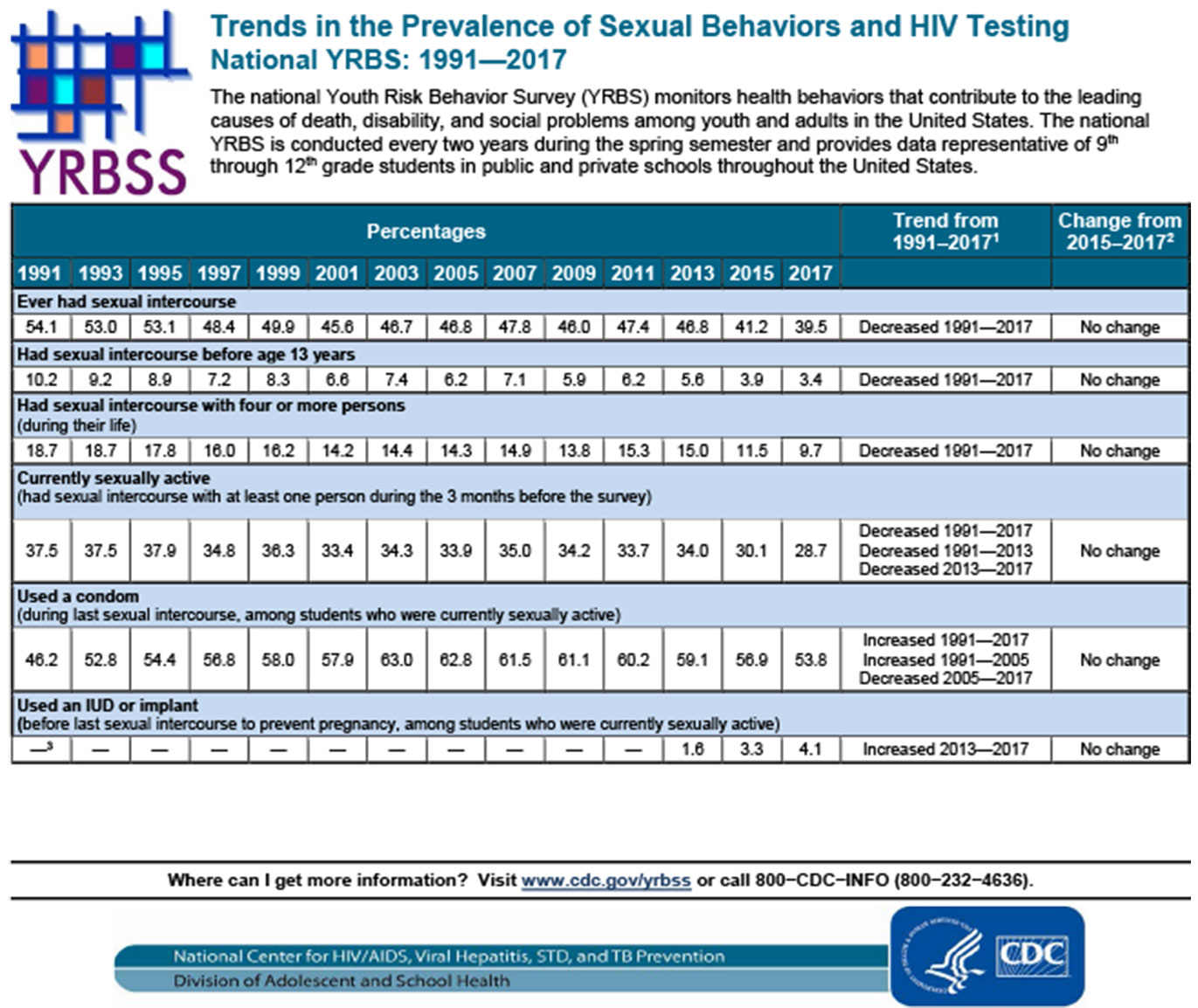New CDC Study Settles the Question: Which Sex Education Approach is Best for Children?
A recent study by the U.S. Centers for Disease Control and Prevention (CDC) goes a long way in settling an important question being bitterly debated in the U.S. and worldwide: abstinence education (AE) or comprehensive sexuality education (CSE)—which approach is best?
Biennially, the CDC releases a “Youth Risk Behavior Surveillance” (YRBS) report—a snapshot of the range of the risk behaviors of America’s teens. In addition to asking youth questions regarding risk behaviors such as drug use or eating habits, the survey also asks teens about their sexual activity.
And the recently released YRBS report for 2017 has some very good news.
The 2017 YRBS survey found that a full 60.5 percent of U.S. high school teens reported they have never had sex! And the trend toward abstinence is going up, not down, with a 1.7 percent increase in the number of teens choosing abstinence since 2015.
In other words, the majority of U.S. teens are NOT having sex!
One of the most important findings of the CDC study was that “Students who had no sexual contact have a much lower prevalence of most health-risk behaviors compared with students who had sexual contact with only the opposite sex and students who had sexual contact with only the same sex or with both sexes.”
Conversely, students who reported they had had sexual contact, whether heterosexual, homosexual or bisexual, were found to have much higher rates of other risk behaviors related to violence, suicide, tobacco, alcohol, drug use, diet, and more.
The benefits of teen abstinence are well known. Certainly, abstinent teens are not going to contract an STD, get pregnant, suffer the health consequences of abortion, or be faced with raising a child alone.
When other positive benefits of abstinence are also factored in, including improved academic performance and less depression, this makes a compelling case for promoting abstinence-based sex ed.
Also, there is a rather simple way to resolve the intense debates regarding CSE and AE.
Simply ask the question, what type of sex education has been shown to be most effective in protecting children? Based on the CDC survey findings as well as numerous other studies and plain common sense, it is clear that adolescents should be encouraged to refrain from sexual activity. On this, very few people disagree.
The next logical question to be asked is which approach to sex education is the most effective in delaying sex? Fortunately, rigorous research has been done on the effectiveness of both approaches.
Recently, the highly respected Institute for Research and Evaluation (IRE) examined these research findings on school-based CSE programs, applying standards from the field of prevention research.
The results of this review were disastrous for CSE advocates. You can find the full report here and a summary of it here, but this is the overall conclusion:
“Using meaningful and recommended criteria (12-month post-program effects for the intended population on key protective indicators), we found insufficient evidence of effectiveness of U.S. school-based CSE at decreasing teen pregnancy or STD rates or increasing teen abstinence or condom use. There was far more evidence of CSE failure than success.”
The last point made in the report is especially important. The data show that some of these CSE programs actually resulted in an increase in sexual risk behaviors among youth. (You can learn more about how CSE harms children in our documentary, “The War on Children,” and from other material posted on our website, www.StopCSE.org.)
The report further stated, “With regard to school-based AE [abstinence-based education], we found promising evidence for producing sustained increases in teen abstinence, enough to justify additional research.”
In fact, they found seven studies that showed effectiveness for AE programs in promoting abstinence, compared to 0 for CSE programs, exposing once again the lies perpetuated by many CSE advocates that abstinence-based programs have been shown to be ineffective or even harmful.
Finally, the IRE recommendation is especially important for the abstinence/CSE debate:
“With regard to sex education in the United States:
1) Given the substantial evidence of program ineffectiveness as measured by meaningful standards from the field of prevention research, and the negative effects found in several studies, we do not recommend comprehensive sex education as a viable public health strategy in U.S. school classrooms.
2) Replication studies should be conducted to verify the positive findings for school-based abstinence education, in order to better inform public policy.”
The burden of proof is on those who are pushing for the adoption of CSE programs to produce credible, independent research that CSE is effective and not harmful.
They will not be able to do it.
Unless, that is, they twist the data like they have done in the past. The IRE study clearly shows just how distorted the claims regarding the effectiveness of CSE are.
For the health, safety, and well-being of youth, abstinence is the best choice.
We will soon be announcing new findings that reveal the same pattern internationally as in the U.S.—that there is more evidence of failure than success for school-based CSE programs.
Please spread this information far and wide.
Defend the Family – Donate Today!
Family Watch International is a Section 501 (c)(3) organization under the IRS code, so contributions are tax-deductible for U.S. taxpayers.
For information on making your donation by bank wire click here or email us at donate@familywatchinternational.org.






